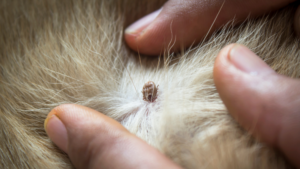
As the weather gets warmer, we all begin to spend more time outdoors. With more outdoor gatherings comes interaction with outdoor pests. But, we’re not talking about spiders or ants here. We’re talking about fleas, ticks and mosquitoes.
While these pests may be annoying to us as humans, they can be dangerous and even deadly for your pets. So, let’s take some time and talk about how these creepy creatures can make your furry friends sick.

FLEAS
Wildlife, including opossums, coyotes, raccoons, and skunks, and even untreated cats and dogs can deposit flea eggs into a yard. You can reduce the risk of unwanted pests in your yard by installing fencing, but that isn’t necessarily a foolproof method. You may also be able to find specific plants that will deter intruders into your yard or apply certain pesticides to your lawn to get rid of and prevent fleas.
Ask your local nursery or landscaping company for tips on what plants or preventatives may be effective and available in your area for your lawn. Just remember, you want to be sure that anything you plant in your yard or apply to your lawn won’t harm your pet in the process!
In order to survive, fleas feed off the blood of the host. Although fleas are tiny (only one to three millimeters in length) they feed twice a day and consume 15 times their body weight in blood! The result can be a life-threatening loss of blood that can cause anemia, particularly for puppies and kittens. Other medical issues include itching, skin damage, allergies and parasites such as tapeworms. In addition, pets that are allergic to flea bites can suffer excessive scratching, hair loss and skin conditions such as dermatitis. Not to mention the fact that fleas can also feed on human hosts!
Fleas thrive in warm, humid environments which make your pet’s coat an ideal place to be. A flea’s life cycle can range from 16 days to 21 months depending on various factors like temperature and humidity. On average, female fleas lay 40 to 50 eggs a day, which means there is no such thing as a “little” flea infestation.
Fleas are most active in warm climates and during the summer months, but these pesky insects can be annoying year-round if they find their way indoors. Once fleas invade your home, they are difficult to eradicate and often require costly and repetitive pest control remedies. Keeping your yard free from pests and making sure that other pets that may come over for a visit are flea free is a great policy to keep your family (four footed and two footed alike) and home flea free!

TICKS
You may be saying to yourself, “I don’t live in a wooded area, so I don’t have to worry about ticks in my yard”. Well, you’d be wrong! Ticks love to hide in areas with great cover. If you, or your neighbors have tall grass, unruly shrubs and piles of debris or leaves, those places can be tick heaven! If you like to spend time outdoor hiking, camping, hunting or fishing you can inadvertently pick up ticks and bring them home with you. So, be vigilant and do self-checks for ticks (or do as the monkeys do and have someone check you over) before spending time with your pet.
MOSQUITOES (HEARTWORM)
If you’re not familiar with Heartworm, you should be. Heartworm is a long, thin worm that is transmitted by the bite of infected mosquitoes. Dogs are most susceptible to Heartworm, but cats can get Heartworm as well (although it is rare). Check out this video from the American Heartworm Society about how Heartworm is transmitted and can affect your pet.
Over 1 million pets have been diagnosed with Heartworms in the US. But, the good news is that Heartworm is preventable. The bad news is that there is no cure for Heartworm in cats. So prevention is the only way to avoid your cats from succumbing to this illness. There is treatment available for dogs, but these treatments can cost thousands of dollars in the process.
PREVENTION
Despite our best efforts to reduce the possibility of fleas, ticks and mosquitoes in our yards, our pets may still be exposed to these parasites, so we want to make sure we are covering all the bases when it comes to prevention.
One untreated pet can lead to a flea infestation or transmission of ticks or other internal parasites like hookworm, roundworm and tapeworm to every other animal in the household. Your veterinarian can perform a painless blood test on your pet annually to check for Heartworm and may ask you to collect a fecal sample from your pet(s) to check for other parasites; which if left untreated, can be devastating for the health of your pet.
Topical products can help protect your cats and dogs from unexpected flea and tick sources by killing adult fleas, eggs and larvae, and all stages of ticks. By putting your pets on a monthly topical regiment, this will prevent you from having to apply lawn treatments that may or may not work. Monthly medications for Heartworm prevention for all pets are also highly recommended allowing your pet to be happy, healthy and safe from possible infection.
Consistency is definitely the key here. Even one missed dose of your monthly preventative treatments can set the stage for a flea infestation that takes months to resolve, put your pet at greater risk of exposure to a tick borne illness or need to be treated for Heartworm or other parasites. So be sure you treat your pet now and continue monthly applications throughout the rest of the year! Don’t think that your pet can’t be affected in colder months. Once fleas, ticks or mosquitoes make their way into your home, they can survive and thrive in a warm house.
Your pets deserve the best! Ask your veterinarian what medications and other types of prevention are best for your pet and your budget.
For more information about fleas, check out this article on PetMD.com.
For more information about ticks, check out this article on the Center for Disease Control and Prevention (CDC) website.
For more information about Heartworm, you can check out the American Heartworm Society.

